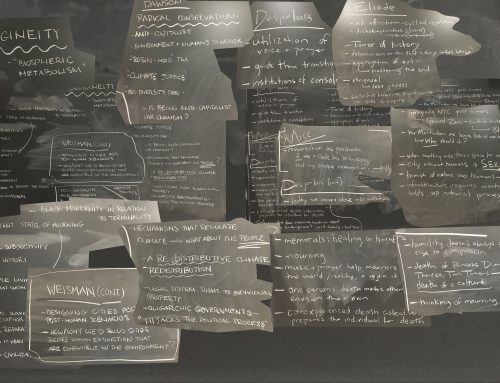Group: Raphael Barnes, Jack Plants, Claire Paterson
We designed a fallout shelter based loosely on the Cannonball shelter/communication tower in the Appalachian mountains, which we have dubbed the “Fallout Monastery”. In our scenario, some sort of ecological catastrophe having to do with fungi has occurred, thereby marking the impending mass extinction of humankind. This hypothetical scenario is rooted in the findings of modern mycologists on mycelium, the vegetative part of fungi and fungi-like bacterias, which consists of thread-like filaments that–incredibly enough–run underground between approximately 90% of all land-based fungi and plants, forming the mycelia network. This network serves an essential purpose as a means of communication, a defense mechanism that fights infection and insects, and a shipping route for nutrients such as carbon, nitrogen, and phosphorus between those in the network which–in many cases–is the sole factor allowing for the survival of seedlings and spores alike.
Mycologists have found that fungi have the potential to eradicate carbon-based pollutants (such as petroleum in oil spills), filter harmful chemicals and microorganisms from soil and water, and even destroy neurotoxins used in chemical weapons. On the other hand, though, Fungi literally consume carbon–the atomic backbone of almost all organic molecules. Fungi have destroyed entire forests, wiped out plant species, devoured man made textiles and supplies, and apparently were the cause of the mass dinosaur extinction 250 million years ago that marked the transition from the Permian period to the Triassic period. Most importantly, fungi kill almost 1.5 million people each year, and hospitalize many more.
Human disruption of the natural environment has strengthened the multi-million specie fungi kingdom–rising planetary temperatures have expedited fungal evolution, which has strengthened and diversified the mycelia network and populated the atmosphere with fungal spores and organisms. Humankind maintains a very delicate relationship with fungi, and there is a good deal of speculation in the mycological world that said relationship could soon sour, resulting in an unbeatable pandemic.
In our scenario, this fungal catastrophe results in a radical reconception of the secular human world by a collective of individuals hailing from multifarious disciplines–religious leaders, scientists, scholars, and so forth– as the actualization of this fungal end time scenario has led to a “melding” of once separate and oft opposed ideological positions. The perceived invincibility, intelligence, and destructive power of the mycelium network disrupts modern notions of secular time (a “re-sealing” of the “open” future) and human agency/free will, and catalyzes the emergence of a concept of ecological predeterminism or predestination akin to once-believed concepts of divine predeterminism or predestination. Ultimately, we find the end of the reign of secularism as the dominant framework for world order construction, and the resultant formation of a cooperative that is rationally or scientifically informed yet religiously inclined.
The Fallout Monastery is designed with two purposes in mind: worship and preservation. The mushroom, conceived of as an entity more powerful than humankind, is deified and thus feared, revered, and worshipped. The bottom floor of the monastery consists of a space for the growing of mushrooms, which of course would naturally link up to the mycelium network, but the act of cultivation is understood as a means of appeasing the fungal deities– perhaps in the sense that the cooperative’s care for, and appreciation of, the mushrooms they grow will lead the fungi to communicate on the mycelia network and put the congregation of the Fallout Monastery in the “good books” of the Fungi kingdom. A process of cultivatory eco-worship, perhaps. The floor above the bottom floor consists of mushroom iconography, and an altar of sorts for other ritualistic practices.
The top floor is for preservation– it is entitled “The Great Library”. The Great Library, as its title indicates, is an extensive archival space for the preservation of the “most essential” creations, discoveries, and components of human civilization. The members of the cooperative effectively sacralize the things they elect to keep in this archive– which makes the great library a sort of physical representation of the distinction between the sacred and the profane; the sacred being that which lies inside the shelter, the profane being the ruins of the human world outside of the shelter.
The Fallout Monastery is a post-human concept, in that it was created by way of a reimagining of human existence– a reimagining beyond the anthropocentric self, and beyond preconceived notions of the secular, sacred, and profane.
Works Cited:
Paul Stamets, Mycelium Running: How Mushrooms Can Help Save the World. Ten Speed Press, Berkley, 2005.
http://www.bbc.com/earth/story/20141114-the-biggest-organism-in-the-world?ocid=twert
Ploetz, R. C. 2005. Panama disease, an old nemesis rears its ugly head: Part 1, the beginnings of the banana export trades. Online. Plant Health Progress doi:10.1094/PHP-2005-1221-01-RV.
Reese, E.T.. Thu . “History of the cellulase program at the U. S. Army Natick Development Center”. United States. doi:.
http://www.sciencemag.org/news/2009/10/fungus-ate-world

Recent Comments